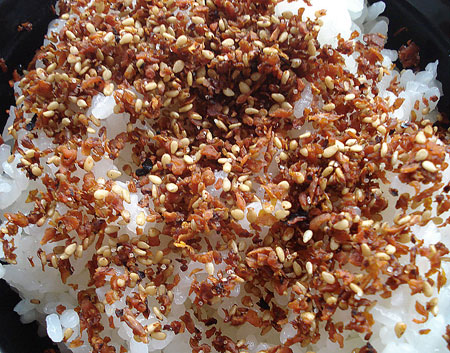Homemade furikake no. 2: Carrot and sesame seeds
Carrots are a staple of just about everyone's fridge I think. They are really good for you, but it can be rather hard to find different ways of eating them. This sweet, savory and spicy furikake uses up whole carrots as well as bits of carrot left over from other uses. Plenty of sesame seeds are added for flavor and texture - and they're not bad for you either. The warm, brown-orange color perks up a dull looking bento, especially on white rice.
I do not subscribe to the Jessica Seinfeld 'hiding vegetables in dubious ways in your food' school of feeding your kids, but if they like furikake, it doesn't hurt to try this on them.
Unlike most furikake recipes, this doesn't have bonito flakes in it so is vegan.
Carrot and sesame furikake
- About 4 medium carrots, enough to make 2 cups (480ml) of finely chopped or grated carrot
- 4 tablespoons sesame seeds
- 2 tablespoons soy sauce (use 'light' soy sauce (not low-salt, the light-colored kind) if you want this to end up more orange and less brown)
- 1/2 tablespoon raw cane sugar or light brown sugar
- 1/4 teaspoon (or to taste) nanami tohgarashi (Japanese 7-ingredient red pepper powder, preferably one with yuzu peel in it), or red pepper flakes
- Salt to taste
Equipment: a large non-stick frying pan or sauté pan; food processor or grater
Peel and finely grate or chop the carrots - a food processor makes this go a lot faster.
Heat up the non-stick pan over low-medium heat. Put in the carrots, and let dry-cook slowly (kara iri), stirring occasionally, until it's dried out quite a bit and has reduced to about 1/4th of its original volume. The drier the carrots, the longer the furikake will keep, but you can keep it at the slightly-moist stage as long as you'll be using this up within a week or so. (This stage does take awhile (about 15-20 minutes) but you don't have to watch it constantly.)
Add the soy sauce and stir rapidly until the liquid is evaporated. Using a light-colored soy sauce will help to preserve the orange color better, but a dark one will taste as good. Add sugar.
Shove the carrot aside to make a hole in the middle of the pan. Pour the sesame seeds in there and stir until a couple start to 'pop'. Rapidly stir around and take off the heat.
Add the nanami tohgarashi. Sprinkle a bit onto some plain rice, and taste; if needs it, add a little salt and more nanami tohgarashi if needed.
Makes about 1/2 cup. Store (after it's completely cooled) in an airtight container in the refrigerator, and try to use up within a week. It can be sprinkled on rice, soups, etc.
Notes: about Japanese seven-flavor chili pepper
I use nanami tohgarashi quite a lot - it's one of the staple ingredients in any Japanese kitchen. It has a complex flavor that is much more interesting than plain red chili pepper. But, is it nanami tohgarashi or shichimi tohgarashi? The kanji for it is 七味唐辛子; the 七味 part means "seven flavors", and the 唐辛子 part means chili pepper. 七 is the kanji for seven, but it can be read as "shichi" or "nana". I grew up calling it "shichimi", but sometime in my teens one of my classmates' mothers heard me saying "shichimi" and corrected me, saying it was "nanami". Some people like to avoid the "shi" sound entirely, since it can mean "death" (死)...though I'm not sure that's why the lady thought "shichimi" was incorrect. Anywho - if "nanami tohgarashi" doesn't get understood, try "shichimi tohgarashi"!
If you enjoyed this article, please consider supporting this site by becoming my patron via Patreon.

